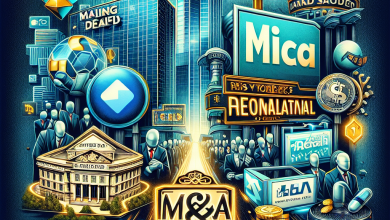Binance: Bitcoin fans should stay away from crypto exchanges
In the world of cryptocurrencies, there is a phrase that has become the mantra of bitcoin fans: “Not your keys, not your coins.” This idiom is intended to warn investors against putting their money on crypto exchanges. Because if something goes wrong there, they cannot access their crypto values. And there are always problems with the platforms – like now with the world’s largest crypto exchange Binance.
Within a day, they had to stop bitcoin payouts twice. The reason: a large volume of pending transactions. In other words, the platform was simply overloaded. In the meantime, the 120 million investors can withdraw their crypto assets again. But the faux pas is embarrassing for the industry leader – and once again shows the problems of central trading platforms.
The Bitcoin payout stop was not an exception. In February, Binance temporarily stopped bank transfers in dollars, paused withdrawals from stablecoins in December and even during the crash last summer, investors were temporarily unable to access their crypto assets. Quite apart from the many differences between Binance and the regulators, true Bitcoin fans should consider storing their money with centralized crypto exchanges.
The basic idea of Bitcoin is to create a payment system without intermediaries such as banks. A system in which no trust is required, but which runs exclusively and forgery-proof via algorithms. But if investors now park their money at a crypto exchange, they again trust a middleman who is supposed to handle the transactions.
And then another one that is significantly more susceptible to systemic risks than established banks. This is also a problem for investors: If a crypto exchange goes bankrupt, the money is lost in case of doubt. It can be attributed to the insolvency estate of the trading platform. Last year, the case of what was once the third-largest crypto exchange FTX showed that this is not a theoretical consideration.
Crypto ABC: The most important terms explained in an understandable way
The focus on the crypto market is clearly on Bitcoin. Altcoins are cryptocurrencies that were invented after the oldest digital currency and represent an alternative to Bitcoin. Examples are Ethereum, Cardano or Solana.
Bitcoin is not only the largest in terms of volume, but also the oldest cryptocurrency in the world. As early as October 2008, Satoshi Nakamoto, the pseudonym of the Bitcoin inventor, outlined what such a virtual currency could look like in a white paper entitled “A Peer-to-Peer Electronic Cash System”. Shortly thereafter, in January 2009, the first bitcoins were mined. Because Nakamoto acted under a pseudonym, it is still unclear who exactly created Bitcoin.
Cryptocurrency transactions are documented on the blockchain. Blockchain is a public, decentralized database. The information is not stored on a single server, but on many thousands of computers. “Chain” comes from English and means “chain”.
Each transaction is stored in a block and appended to a chain of pre-existing records. That is why the blockchain is also called a digital cash book. The stored data can no longer be changed afterwards or only with the consent of the network. This is to create a forgery-proof protocol.
Ether is the second largest cryptocurrency behind Bitcoin and is based on the Ethereum blockchain. Compared to the Bitcoin blockchain, this is considered to be more modern and powerful and will soon be switched to the more energy-saving proof-of-stake process. Smart contracts can also be traded via Ethereum. The cryptocurrency is also popular because NFTs (non-fungible tokens) are often based on Ethereum and are therefore paid for with Ether.
Mining is the creation (digging) of new coins. In this process, in the case of Bitcoin, miners make the computing power of their computers available to solve complex mathematical tasks. This is how transactions are verified and stored on the blockchain. The miners are rewarded with newly generated Bitcoin for providing the computing power.
With some other cryptocurrencies, however, the mining is not based on computing power, but on the shares of the network participants in the respective cryptocurrency (see Proof of Stake). In this case, mining is therefore often referred to as staking. Participants also receive a bonus for this, i.e. a kind of interest on their share.
Minten refers to the creation of an NFT (non-fungible token). In this case, “imprinting” the image means uploading it to the blockchain.
The abbreviation NFT stands for non-fungible tokens, i.e. non-exchangeable tokens. NFTs are virtual goods traded on the blockchain. These are often digital images or trading cards. Every NFT is unique. Anyone who buys one is registered as the owner in the blockchain and can therefore show a certificate of authenticity for a virtual image or a digital work of art, for example.
With the proof-of-work process, new coins of some cryptocurrencies such as Bitcoin are created. The miners make the computing power of the system available to solve complex tasks. Whoever manages to solve the task first can attach the block to the blockchain and receive a reward in the form of digital coins. The proof-of-work approach is considered to be particularly energy-intensive.
Some blockchains are based on the Proof of Stake process. Unlike Proof of Work, mining does not require extensive hardware and large amounts of computing power. Proof of Stake is therefore considered to be much more energy-efficient.
Instead, those transactions and new coins that hold a particularly high proportion of a cryptocurrency are allowed to release them. They are then called validators. The process is based on a consensus mechanism. The higher the price, the higher the number of coins to participate in the process.
Smart contracts are virtual contracts that are exchanged over the blockchain. These come into force independently under certain previously defined conditions. Banks and other financial institutions in particular see great benefits in smart contracts. For example, they could make intermediaries – i.e. intermediate bodies such as securities brokers – superfluous in stock exchange trading.
The wallet is a kind of digital purse for cryptocurrencies. It allows users to buy and send crypto assets. There are several types of wallets. The hardware wallet is essentially a USB stick on which a user’s crypto assets and access are stored. A paper wallet is printed out on paper.
A QR code is generated for this, which you have to scan in order to make transactions. A software wallet does not require external devices or paper printouts. Here the data is stored in a computer program. Users must not forget their access data: otherwise they would be denied access to their crypto assets.
This crypto ABC comes from the big one Crypto 1×1 from WirtschaftsWoche: You can download the complete dossier here
In an emergency, investors pay a high price if they trust a central exchange. But there is also an alternative to Binance and Co.: private wallets, i.e. digital wallets that investors manage themselves. This can be done, for example, via wallet USB sticks such as the Ledger Nano or via so-called wallet papers. These are papers on which the additions are noted.
Although this is more complex than custody via a crypto exchange, it is more secure. However, your own urge for order should inspire more confidence than a trading platform. If you lose access to your wallet, the deposits are lost in the worst case. After all, there is no customer service at home that can help you out of a jam.
Also read about Bitcoin:
- Money Machine 3.0: The Sinister Rise of Binance Crypto Exchange
- Bitcoin Halving 2024: Countdown to the next Bitcoin Halving
- Bitcoin Mining Explained: What is Bitcoin Mining and How Much Energy Does it Really Use?





